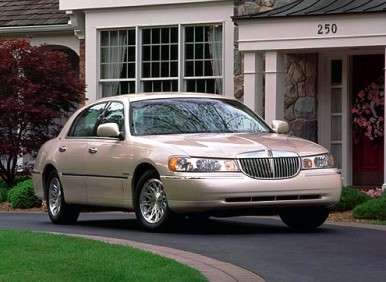Recent Articles
Popular Makes
Body Types
Lincoln Town Car Used Car Buyer’s Guide
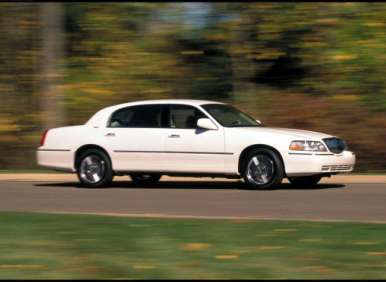
The car most people envision when they hear the word” limo”, Lincoln’s Town Car practically had the livery trade completely sewn up over the course of its lifetime (and frankly, it still does for the most part). The last surviving large rear-drive American luxury car, the Lincoln Town Car is a throwback to the era of “longer, lower, and wider” American luxury sedans. The Lincoln Town Car was also the largest sedan available in North America in its final years of production.
The Town Car appellation was first appended to a Lincoln product back in 1959. It found permanence when it appeared as a trim package for the 1969 Lincoln Continental. It became a standalone model unto itself in 1981, when Lincoln’s product planners decided to position the Town Car above the Continental in the Lincoln lineup. Many have speculated this was done because the Continental was moving to a front-drive platform, and Lincoln’s marketers recognized the value of the rear-drive Town Car for the livery business.
Whatever the reason, the Town Car has been wildly successful as a chauffeur-driven automobile. Exceptionally robust, easy to repair, and of course highly comfortable to ride in; Lincoln’s Town Car singlehandedly ruled the limo business until it was discontinued after the 2011 model year.
And frankly, the market has yet to come up with a suitable replacement.
Lincoln produced three generations of the Town Car between 1981 and 2011. This retrospective will pick up with the launch of the third generation car, which ran between 1998 and 2011.
Lincoln Town Car Used Car Buyer’s Guide: 1998 – 2011
The third generation Lincoln Town car benefitted tremendously from the recognition of its designers of its value to limousine business. Well, with one exception. Its curvaceous design compromised the cargo capacity of the trunk, limiting the amount of luggage that would fit, but other than that, it was the quintessential American chauffeur-driven car. There was even a stretched wheelbase iteration of it introduced in the 2000 model year. That one catered even more specifically to the limo business.
At launch, the third generation Lincoln Town Car was powered by a 200hp, 4.6L V8, which made 265 foot-pounds of torque. A four-speed automatic shouldered transmission duties throughout the lifetime of the model. Its styling was a radical departure from all of the previous Town Cars. Where those cars wore laser straight lines, opera windows, an upright Rolls-Royce-ish grille with a hood ornament, and sharply angled corners; the 1998 Town Car was fluidly curvaceous. Its grille resembled a waterfall and opera windows (a former signature styling cue) were nowhere to be found (except on the extended wheelbase “L” models built from 2003 forward).
Interestingly, while the Gen3 Town Car’s overall length was less than that of the 1997 Lincoln, its wheelbase was actually longer. Additionally the Gen3 Town Car was taller and wider than its predecessor. And yes, this translated into more space in the passenger compartment. Reviewers of the time received the car pretty well—for what it was—though many noted it lagged most contemporary automobiles considerably in terms of braking, handling and acceleration.
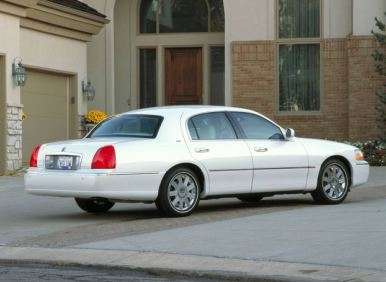
Lincoln Town Car Used Car Buyer’s Guide: 1998
The 1998 Lincoln Town car was offered in three iterations. The base model was designated “Executive Series”, the mid-level model was called “Signature Series”, and the top of the line 1998 Lincoln Town Car was the “Cartier Edition”.
Standard equipment for the 1998 Lincoln Town Car Executive Series model included; 16-inch alloy wheels, heated exterior door mirrors, a keyless entry system, a lighted entry system, power brakes, a rear window defroster, tinted glass, a power adjustable driver seat with memory, a power adjustable passenger seat, cloth upholstery, a self-leveling suspension system, and a clock. The 1998 Executive model also included traction control, four-wheel ABS, driver and front passenger airbags, an antitheft alarm system, cruise control, and power steering.
A remote trunk release, a self leveling suspension system, a leather trimmed tilt steering wheel, automatic climate control, intermittent windshield wipers, power windows and door locks, automatic headlights, and auto dimming interior and exterior rearview mirrors were included in the base price. The audio system used an AM/FM cassette head unit.
Optional features for the Lincoln Town Car Executive Series sedan included leather seating surfaces and a compact disc changer.
The Signature Series sedan used all of the standard features above, plus; an integrated garage door opener and steering wheel audio controls. Options for the Signature Series included chrome wheels, a cellular phone, leather seating, a compact disc changer, fog lights, heated front seats, a power moonroof, and an AM/FM/cassette/CD head unit with a JBL amplifier and speakers.
The Cartier Edition was fitted with a Cartier clock (thought it wouldn’t be?) as well as all of the above as standard features; with the exception of chrome wheels, a cellular phone, a compact disc changer, and the power moon roof. Those items were available as options. It also got a dual exhaust system for the 4.6L V8, which improved its power output to 220hp and 275 foot-pounds of torque.
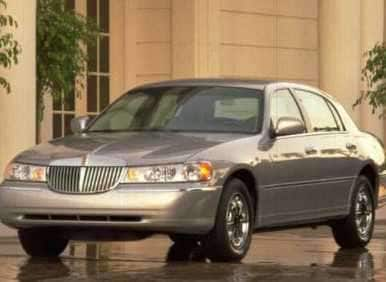
Lincoln Town Car Used Car Buyer’s Guide: 1999
Side/curtain airbags were added to all models and the premium JBL audio system was upgraded. Cup holders were added to the rear seat fold-down armrest on Executive Series Town Cars, and the power seat controls were moved to the doors on all models. A two-tone paint job and improved interior door trim were also available as options. All three models got the dual exhaust system. Engine tweaks raised the torque output to 280 foot-pounds, but horsepower was reduced to 205.
The long wheelbase “L” version Cartier Edition and Executive Series Town Car models were introduced for the 2000 model year. New safety features included an emergency trunk release and child seat anchors. The Lincoln's Belt Minder seatbelt system used a chime and an indicator light to remind passengers to fasten their seatbelts. The front passenger door trim panel gained a storage armrest.
More fiddling with the engine raised power output for Signature and Cartier Town Car models to 220hp and 290 foot-pounds of torque. The Executive Series cars soldiered on with the 205/280 numbers from the previous model year.
Special features of the “L” cars included six more inches of rear seat legroom, remote access audio and climate controls mounted in the rear center armrest, and a two-way travel switch for the front passenger seat—enabling the right rear passenger to move the seat for even more legroom.
“L” cars built between 2000 and 2002 can be readily identified from the outside by a wide glossy black panel wearing the Lincoln "star" ornament. This panel covered the wider ‘B” pillar forward of the window glass on the elongated rear doors that were also specific to L-package cars.
For MY2000, the consumer L package was limited to the Cartier Series. The Executive Series L package was offered only to fleet buyers, primarily for the limousine business.
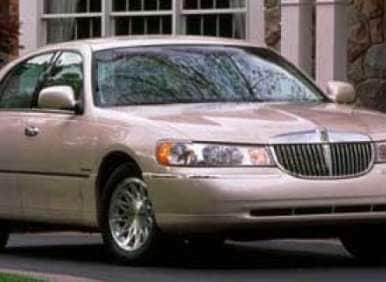
Lincoln Town Car Used Car Buyer’s Guide: 2001
Power increases endowed the Lincoln Town Car Executive Series and Signature Series models with 220hp (up from 205), but torque was decreased to 265 foot-pounds of torque (down from 280). The Cartier Series cars got a power increase on the horsepower side to 235 (up from 220), but torque was decreased to 275 foot-pounds (down from 290).
An adjustable pedal set, seat-belt pre-tensioners, redesigned map pockets, and a set of leather grab handles were added to the standard equipment list for the Executive Series, which meant all Town Car models got them. Signature Series models were fitted with a wood-trimmed steering wheel, while the front seats in all models gained power lumbar adjustment.
By MY2001, all Town Cars came with leather seating surfaces, an automatic climate control system, a full set of antilock disc brakes, traction control, front and side airbags, and memory seating.
The 2001 Signature Series Town Car featured an Alpine audio system, and steering wheel-mounted controls for the audio and climate-control systems. Meanwhile, the Cartier Series Lincoln Town Car flaunted higher-grade leather, heated seats for the driver and front passenger, a set of 16-inch chrome wheels, and a Cartier clock.
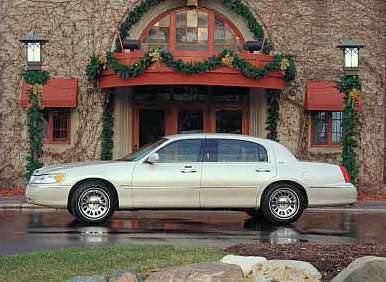
Lincoln Town Car Used Car Buyer’s Guide: 2002
Lincoln offered an optional Vehicle Communication System (VCS) starting with the 2002 Town Car. Essentially Lincoln’s version of OnStar, opting for VCS also bought a portable hands-free, voice-activated Motorola Timeport analog-digital cellular phone. With it, subscribers could access SOS safety and security services; along with news, stock quotes, weather; and route guidance assistance.
By 2002, there were some eight versions of the Town Car offered, these were Executive, Signature, Signature Touring, Premium Touring, Premium Signature, Cartier, Premium Cartier, and Cartier L.
The standard feature set of the 2002 Lincoln Town Car Executive Series sedan included 16-inch alloy wheels, variable intermittent windshield wipers, a rear window defogger, a 220hp V8 with 265 foot-pounds of torque, eight-way power adjustable driver and front passenger seats with manually adjustable lumbar support, and leather upholstery.
The rear seat featured a folding armrest with storage, and ventilation ducts from the automatic climate control system. The power door locks could be opened with a digital keypad; there were also heated power adjustable exterior mirrors, and a one-touch power window for the driver.
Other standard features included cruise control, an adjustable pedal set, a front console with storage, front and rear cup holders, front and rear door pockets, a remote trunk release, and the Executive Series Town Car retained accessory power when the engine was shut down. The model used speed proportional power steering, a 12V power outlet, and its tilt adjustable leather–wrapped steering wheel featured switches for the cruise control system.
The automatic climate control system used a sun sensor, there was a trunk light, front and rear reading lights, front and rear floor mats, an electrochromatic auto dimming inside rearview mirror, and dual illuminated vanity mirrors. Naturally, there was a clock, a trip computer, an external temperature display, a low fuel level warning indicator, and a compass. The audio system consisted of an AM/FM stereo head unit.
The safety and security package was comprised of four disc brakes with ABS and electronic brake force distribution, traction control, dual front side-mounted airbags, a front center lap seatbelt, a rear center three-point seatbelt, front and rear seatbelt pre-tensioners, cornering lights, auto delay off and dusk sensing headlamps, and an engine immobilizer.
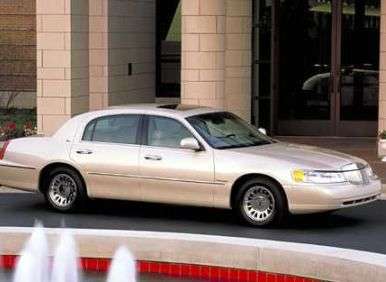
Lincoln Town Car Used Car Buyer’s Guide: 2003
The third-generation Lincoln Town Car got an extensive refresh for the 2003 model year. While the trim lines remained the same; “Executive Series”, “Signature Series” and, “Cartier Series” the look of the car both inside and out was considerably updated. The hood ornament returned and the grille was updated to look more like the one on the Lincoln LS of 2003.
The sole engine offering for 2003 was a 4.6L V8 making 235 horsepower and 275 foot-pounds of torque driving the rear wheels through a four-speed automatic transmission.
Standard equipment for all 2003 Lincoln Town Car models included a dual-zone climate control system with vents for rear passengers, a set of 17-inch alloy wheels, speed-sensitive rack and pinion steering, and a new analog clock. The 2003 Town Car also gained remote keyless entry, a power trunk closing feature (called “Trunk At A Touch”), a power-adjustable pedal set, an eight-way power adjustable driver’s seat, and dusk sensitive automatic headlamps capable of activating themselves when the windshield wipers were in use.
Moving up to the Signature Series gained a leather-and-wood-trimmed steering wheel, upgraded leather upholstery, and plush deep-pile carpeting. Also part of the package was a memory system capable of retaining seat and mirror settings for up to two different drivers. There was also a set of heated front seats, a parking assist system, and rain-sensing intermittent windshield wipers.
The top of the line Cartier Series placed a first-aid kit in the trunk and was fitted with Cartier-embroidered seats and floor mats. The ultra-luxury Town Car also used chrome wheels, a set of halogen driving lights, and for the long-wheelbase L model, the rear seats were heated.
Key model year 2003 Lincoln Town Car safety features included the Lincoln Personal Safety System. This was comprised of a pair of dual-stage front airbags, seat-mounted side airbags, three-point seatbelts for all outboard seating positions, and a BeltMinder chime to remind occupants to fasten seatbelts. Ultrasonic park assist was standard on all Town Cars except the Executive Series.
LATCH child seat anchors were added, as was a five-mph bumper system. Traction control, four-disc brakes with ABS, electronic brake force distribution, and brake assist were also included in the base price.
Optional for Cartier Series cars was high-intensity discharge headlamps. The Lincoln Vehicle Communication System (VCS), returned, but was upgraded. For 2003, its key features included automatic airbag activation notification, initiated emergency assistance, roadside assistance, and hands-free dialing of its portable Motorola Timeport telephone.
On the cosmetic front, the seats were redesigned to include larger headrests, and the dash was fitted with satin metal trim—in addition to the standard woodgrain. The center stack got a new radio face, and the climate control interface was updated to integrate an analog clock. A DVD-based satellite navigation system designed by Pioneer was offered as an option and was eventually paired with THX sound processing.
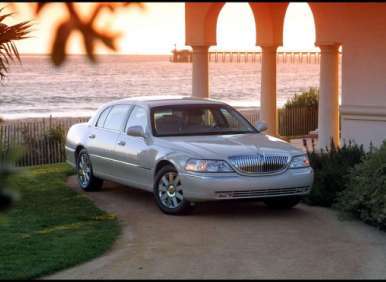
Lincoln Town Car Used Car Buyer’s Guide: 2005
The steering wheel was updated to a two-spoke design. The 2003 Signature Series trim set was reinstated and dubbed Signature Limited. The long-wheelbase L package was fitted to the Signature Series trim line, and the navigation system was bundled with a THX-certified audio system featuring satellite radio compatibility.
With the previous changes in 2004 and 2005, and the new trim lines introduced for the 2006 model year, Lincoln’s Town Car offerings shaped up with three available trim lines. These were; “Signature” and Signature Limited”, while the “Ultimate” iteration of the car was renamed “Designer Series”. The 2006 Signature Series Lincoln Town Car was offered in both regular- and long-wheelbase (called the L) formats.
Standard equipment for the Signature Series included a set of 17-inch alloy wheels, a dual-zone automatic climate control system with vents for the rear passengers, leather upholstery, a pair of eight-way adjustable power front seats, a power-adjustable pedal set, a CD player, an analog clock, automatic dusk-sensing headlamps, and rear parking sensors.
The Signature Limited Town Car featured all of the above; plus heated front seats, driver seat memory, a wood-and-leather steering wheel, an upgraded audio system with an in-dash CD changer, and a full power trunk opening/closing system.
The Designer Series package brought chrome trim, ultra-plush Provence leather seating surfaces, a set of adjustable rear headrests, and two-tone door panels.
The long wheelbase Town Car Signature Series L added a six-inch wheelbase stretch for increased rear-seat room. True to its mission as a primarily chauffer-driven car, it featured dual rear-seat power points, four-way rear head restraints, heated rear seats, and remote controls for the audio and climate systems—in addition to a control for moving the front-passenger seat.
A la Carte options included HID headlights, a set of chrome wheels, a trunk-mounted CD changer, a moonroof, and a navigation system paired with a THX-certified audio system.
The power-open and -close trunk feature was added to the standard equipment list for the Signature L trim package.
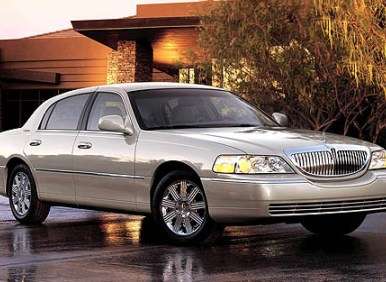
Lincoln Town Car Used Car Buyer’s Guide: 2008
Most trim lines were eliminated, save Signature Limited and Signature L. Signature Limited featured 17-inch alloy wheels, a keyless entry system with a door keypad, the power-closing trunk, a tilt steering column, eight-way power adjustable front seats for the driver and passenger with driver memory settings, a power-adjustable pedal set, heated front seats, a dual-zone automatic climate control system with rear ventilation ducts, an auto-dimming electrochromatic rearview mirror, a six-disc CD changer, and a wood and leather steering wheel—housing audio, climate and cruise control switches.
The long-wheelbase Town Car Signature L model was identically configured to the 2007 model, with the addition of rear-seat vanity mirrors.
Xenon HID headlamps were optional, as was satellite radio (dealer-installed) along with chrome-finished 18-spoke wheels, a white-wall tire option, and a three-bin storage tray trunk organizer designed to reside underneath a hard carpeted cover for the Town Car's center trunk well.
Lincoln’s Town Car went into MY2009 unchanged.
The 2010Lincoln Town Car Signature SeriesContinental Edition package added 17-inch chrome wheels, and chromed B-pillars, along with “Continental” badging and interior stitching on the seats and floor mats.
Lincoln’s Town Car went into MY2011 unchanged.

Lincoln Town Car Used Car Buyer’s Guide: Summary
By the end of its run, the Lincoln Town Car was thoroughly outclassed as a consumer automobile. However, as a limo the Town Car was peerless. The Lincoln was exceptionally spacious (even in its standard wheelbase format), nicely equipped, and very comfortable to ride in.
However, its engine was old, underpowered and thirsty. Its suspension system gave not a single whit about cornering prowess, and its braking system was marginally effective at best. In other words, the car’s dynamics were adequate for the around town and gentle highway use the Town Car was built for, but definitely nothing that would incite excitement in a driving enthusiast.
On the other hand, as a used car purchase, if you avoid the super high mileage former livery Town Cars, you’ll find you can get an exceptionally robust car, with proven mechanicals, that’s very easy to work on. Further, hardly anyone wants them for personal transportation, so you can find some significant bargains (assuming you want to be seen driving the thing yourself).
Yes, there were recalls and the big Lincoln, like every other car has its own particular quirks. Spend some time in Lincoln owner’s forums on the ‘Net and you’ll get a feel for what the problem areas are. You’ll also find the recall information you’ll need to make sure the car(s) you’re looking at have been updated.
Yes, a pre-purchase inspection by an independent, professional mechanic, one well versed in Lincoln’s Town Car is definitely in order. One last admonition, averaging 16 mpg in the city and 24 on the highway, if you’re thinking to buy a used Town Car, make sure you have plenty of gas money.
